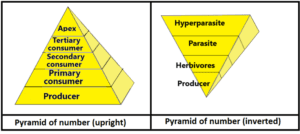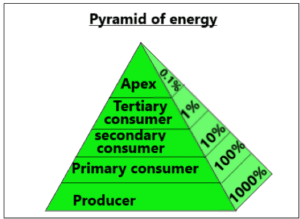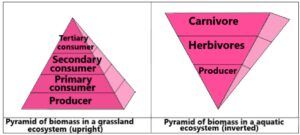Introduction
An ecological pyramid is a part of an ecosystem. In 1939, Charles Elton first introduced the concept of the ecological pyramid. Ecological pyramids are formed around the trophic structure of the ecosystem. The pyramid in the ecosystem consists of a number of layers from the ground to the top. The producer level forms the lower surface and the levels of herbivorous and carnivorous are arranged in sequence respectively. Looking at the trophic levels from the ground to the top of the pyramid, it is seen that the number of organisms in each trophic level is gradually decreasing. The base of the pyramid is formed by the producers and the successive nutrient layers rise to the top. Finally, the apex is formed by the highest consumer. This is the ecological pyramid (2).
Definition
A food pyramid is a pyramid or peak formed by the gradual arrangement of nutrients or food supply based on the food-consumer relationship of an ecosystem.
According to the scientist Charles Elton, the number, energy, and mass of organisms gradually decreased from the producer to the highest consumer, and if added by an imaginary line, the table would take the shape of a pyramid, called an ecological pyramid. The ecological pyramid is also called the Eltonian pyramid because it was introduced by Charles Elton (1).
Characteristics of the Ecological Pyramid
The ecological pyramid has some features like
- Organisms dependent on the same class of food-consumer relationships are located at the same level of the pyramid.
- The ecological pyramid located within the ecosystem consists of two to four layers.
- The producer is located at the lowest level of an ecological pyramid. The number and quantity of producers at this level are very high.
- The highest consumer exists at the highest level of an ecological pyramid. The number and quantity of consumers at the highest level of the ecological pyramid are low.
- The supply of food energy gradually decreases at the top of the ecological pyramid. So the top of the pyramid has a narrow and sharp shape.
- Number of organisms at the top of the ecological pyramid gradually decreases, but their size and volume increase (1) & (3).
Classification of the Ecological Pyramid
The ecological pyramid is mainly divided into three parts.
1. Pyramid of number

The ecological pyramid that is formed by arranging the number of organisms of different nutrient levels in an ecosystem is called the pyramid of numbers. The producers are located at the base of the pyramid. The structural unit of the pyramid of the number is number/sq. m/year (1).
Properties
- Pyramids of numbers can be both upright and inverted.
- The upright pyramid has the highest number of producers at the base level and the number of organisms gradually decreases at the next level.
- In any ecosystem, the pyramid of numbers in the parasitic food chain is always inverted. In the inverted pyramid, the number of organisms in different nutrient levels from the ground to the top gradually increases.
- According to the concept of the ecological pyramid, the number of organisms in a trophic level depends on the number of previous nutrients (1) & (2).
Example
In grassland ecosystems, the number of herbivores is less than that of grass plants. Since carnivores feed on herbivores, so the number of carnivores is lower than that of herbivores. Similarly, the number of carnivores at the highest level dependent on carnivores is the lowest (1).
2. Pyramid of energy

The ecological pyramid which is formed by arranging the amount of energy in different trophic levels in an ecosystem is called the pyramid of energy. The producers located in the base of the pyramid of energy have the highest amount of energy and the trophic level at the top has the lowest amount of energy. The structural unit of the pyramid of energy is kcal/sq. m/year (1).
Properties
The features of this pyramid are:
- The pyramid of energy is always upright.
- This pyramid represents the total energy content of each trophic level in an ecosystem.
- The base of this pyramid has the highest amount of energy earned from solar energy. However according to Lindeman’s 10% law, the amount of energy at the next level gradually decreases.
- Some of the energy that is trapped in organic food is lost in the form of heat energy in respiration, some are used in physiological processes, and the rest is used by decomposers.
- In the pyramid of energy, some energy is lost as energy is transferred from one trophic level to the next. Each level of this pyramid loses 60 to 90% of energy during energy transfer (2) & (3).
3. Pyramid of biomass

The ecological pyramid that is formed by sequencing the amount of dry weight of different organisms according to the trophic level in an ecosystem is called a pyramid of biomass. Depending on the trophic level of an ecosystem, the dry weights of different organisms are arranged in stages, with 15 to 20% of biomass per layer being transported to the next layer. The structural unit of the pyramid of biomass is gm/ sq. m/ year (2).
Properties
- Like a pyramid of numbers, this pyramid can be both upright and inverted. Forest and grassland ecosystems are examples of upright biomass pyramids. The ecosystem of the pond is an example of an inverted biomass pyramid.
- Biomass pyramids are very essential in the food chain.
- The size of a group of organisms is known by this biomass pyramid.
- The pyramid that indicates the total weight of each food layer in a particular food chain in an ecosystem is the biomass pyramid.
- From the primary trophic level of the food chain to the higher trophic level the biomass gradually decreases.
- At the base of this ecological pyramid, the biomass of the producer is the highest and the biomass of the tertiary consumer is the lowest (2) & (3).
Example
In the forest ecosystem, the biomass of the producer is highest and the biomass of tertiary consumers is low. The pyramid of biomass may be inverted in the aquatic ecosystem.
Importance of ecological pyramid
It is part of an ecosystem. So the ecological pyramid has an important role in any ecosystem.
- An ecological pyramid gives an idea of the eating habits of different groups of organisms.
- The number of organisms in an ecosystem is known from ecological pyramids.
- The ecological pyramid gives an idea of the amount of energy transferred from one trophic level to another in the ecosystem.
- An ecological pyramid gives information about the biodiversity of a region.
- The ecological pyramid is formed on the basis of the food-consumer relationship. So if the food chain is destroyed, the ecological pyramid will be destroyed and the whole ecosystem will be severely damaged.
- The ecological pyramid helps in maintaining balance and helps in monitoring the whole condition of an ecosystem (2).
Q&A
What is biomass?
Biomass is the total weight or mass of a species at a given time in a trophic level of an ecosystem. It is calculated in two ways- wet biomass and dry biomass. In an ecosystem, the amount of biomass decreases from the producer to the final consumer or apex.
What is Lindeman’s 10% law?
In 1942, Raymond Lindeman introduced a theory called the 10% law to explain the transfer of energy. According to Lindeman, 10% of energy flows from one trophic level to another trophic level in an ecosystem. This is Lindeman’s 10% law. For example, if a rabbit eats 1000 gm of green plants, then 10% or 100 gm of energy from that food is used for various physiological functions and body heat production in the body of the rabbit. If a hawk eats the rabbit, only 10 gm of energy will be transferred to the hawk’s body, according to Lindeman’s 10% laws.
What is meant by the contrast of the ecological pyramid?
In any ecosystem, the pyramid of numbers in the parasitic food chain is always inverted. Because more than one parasitic animal may be dependent on a tree. Many tiny parasites may be dependent on each of them. So from the base of this type of pyramid to the peak, the number of organisms gradually increases at different trophic levels. This condition is called the contrast of the ecological pyramid.
